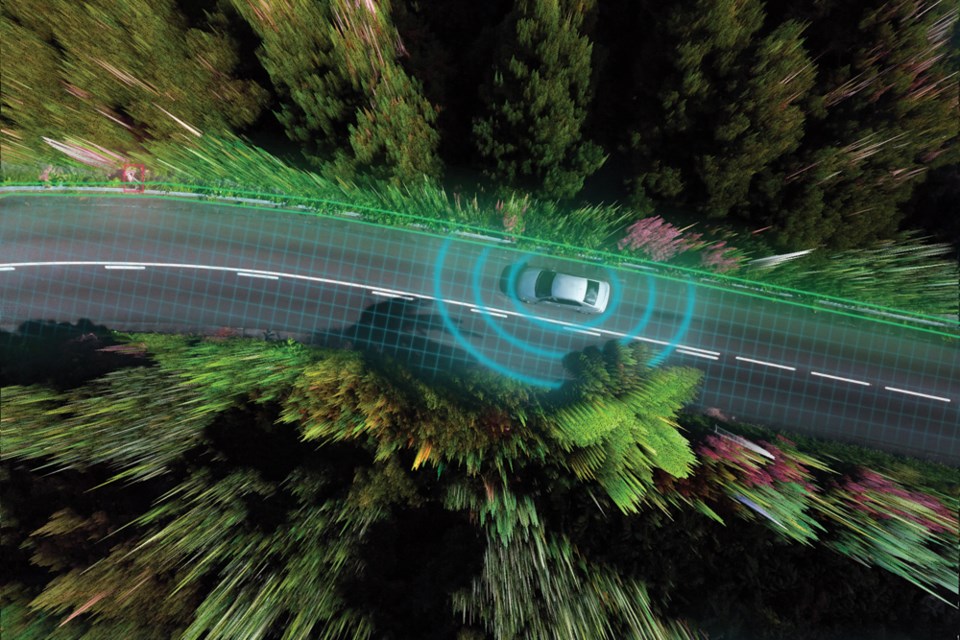What does the future hold for transportation?
Will the North Shore resemble a clean air version of Blade Runner with a phalanx of airborne single occupancy vehicles? Will there be transporters like they have in Star Trek? Not likely. Jet packs? Yes, maybe.
The recently released draft Transport 2050 Strategy from TransLink attempts to address current and future trends. Of the more realistic changes, TransLink thinks that autonomous vehicles (AVs) will be here sooner rather than later and that we should be getting ready.
I was a bit taken aback that TransLink was thinking about AVs so earnestly. To me, they seem unlikely to take over in my lifetime. But then, what if those clever car manufacturers do get the artificial intelligence and sensor systems behind driverless vehicles working sooner rather than later?
First, why are we even going there? It seems like a massive investment in innovation and technology to get to a post-human vehicle world. What are the major “drivers” of the coming AV revolution?
The single most significant benefit of driverless vehicles is that crashes could be reduced by 90 per cent. Yes, 90 per cent. Cars don’t crash. People do. The aggregate savings in healthcare makes removing human drivers from cars a massive public good.
The second compelling reason to remove humans from the equation is to improve road use efficiency. Autonomous vehicles will make better routing decisions, running in concert with each other to significantly improve overall traffic flow.
Not surprisingly, the TransLink strategy is not big on simply converting vehicles from gas-powered vehicles to electric, self-driving models, because that doesn’t mean fewer vehicles will be on the road. The strategy instead emphasizes making public transit more convenient, reliable, and safe, and improving the safety of pedestrians and cyclists. It also recommends promoting shared AVs over individual ownership. If we could all conveniently access a car trip without having to incur the expense of owning and the risk of driving, then that might work.
Here’s a twist that’s not in the strategy. Most major vehicle manufacturers are looking ahead to a time when we live like the Jetsons and fly to work in an autonomous drone. Physically removing traffic from our streets is one way to alleviate jams. We would need to agree on which kind of vehicles could fly, and regulating this would be a nightmare. But, drones would certainly reduce competition for ground-based routes. Hey, I know: Let’s put all the vehicles in the sky and then use contracted roadways for bikes and other micro-mobility options. Right?
But back on planet Earth – as a person who would use a bicycle for transportation in a potential post-driver world, should I be looking forward to an easier ride? After all, we humans will no longer get road rage, cut each other off, run lights, forget to shoulder check and perform countless other misdemeanours. AVs should be better. Turns out that pedestrians and cyclists can be unpredictable. That’s the worst thing for a vehicle that conducts itself based on rules and probability calculations.
According to the TransLink strategy, there are a couple of ways around this problem. We could “channelize” streets to ensure no people outside vehicles are allowed. Wow. Imagine roads cut off from sidewalks by a barrier wall. It would be like living in a rat maze experiment. Got cheese?
Also, we could reduce vehicle speeds across the board, allowing AVs more time to make better decisions while interacting with pedestrians or people on bikes. We might take a dual approach by channelizing some streets and reducing speeds on most. Will lowering road speeds to accommodate self-driving vehicles increase traffic? Remember, you won’t be driving anymore, so it’s not like you care. Computers and sensors are going to do a more efficient job than you. Despite slower speeds, you will likely get where you want to go faster and more safely.
It could perhaps end up that the AI will keep getting better, and we won’t need to alter our roadways completely. In the latest beta of Tesla’s full self-driving autopilot, a car surprised its “driver” when it slowed and moved over to the left after recognizing a cyclist ahead. Yay!
The TransLink strategy also touches on social issues. For example, driverless vehicles don’t require ... umm, well, drivers. A whole bunch of people will be out of work. Bus drivers, Uber operators, taxi drivers, commercial truckers. It’s a lot of people. Also, with crashes down and the growth in electric vehicles, the need for repair shops should diminish. So OK, autonomous vehicles solve one problem – the high cost of accidents – but they create another: tech-related job loss. Of course, the industries that make the sensors and other technologies behind AI-driven vehicles will say that they will create thousands of new jobs. Let’s hope so.
How will insurance work? For some time, there will be a mix of human-directed and driverless vehicles. That should be an interesting combo. Potentially higher insurance rates on cars with humans at the wheel might lead people to convert to AVs sooner rather than later. Driver liability will take a back seat to product liability with AI behind the wheel. The vehicle manufacturer or the automation system supplier would be liable in a crash, not the human. We are already starting to see Tesla facing liability lawsuits over fatalities.
It’s a brave new world. Are you ready?
Heather Drugge is a sustainable transportation advocate who has used her bike for transportation for over 20 years. She’s zooming around on an e-bike now, and maybe looking at a jetpack next. [email protected].



